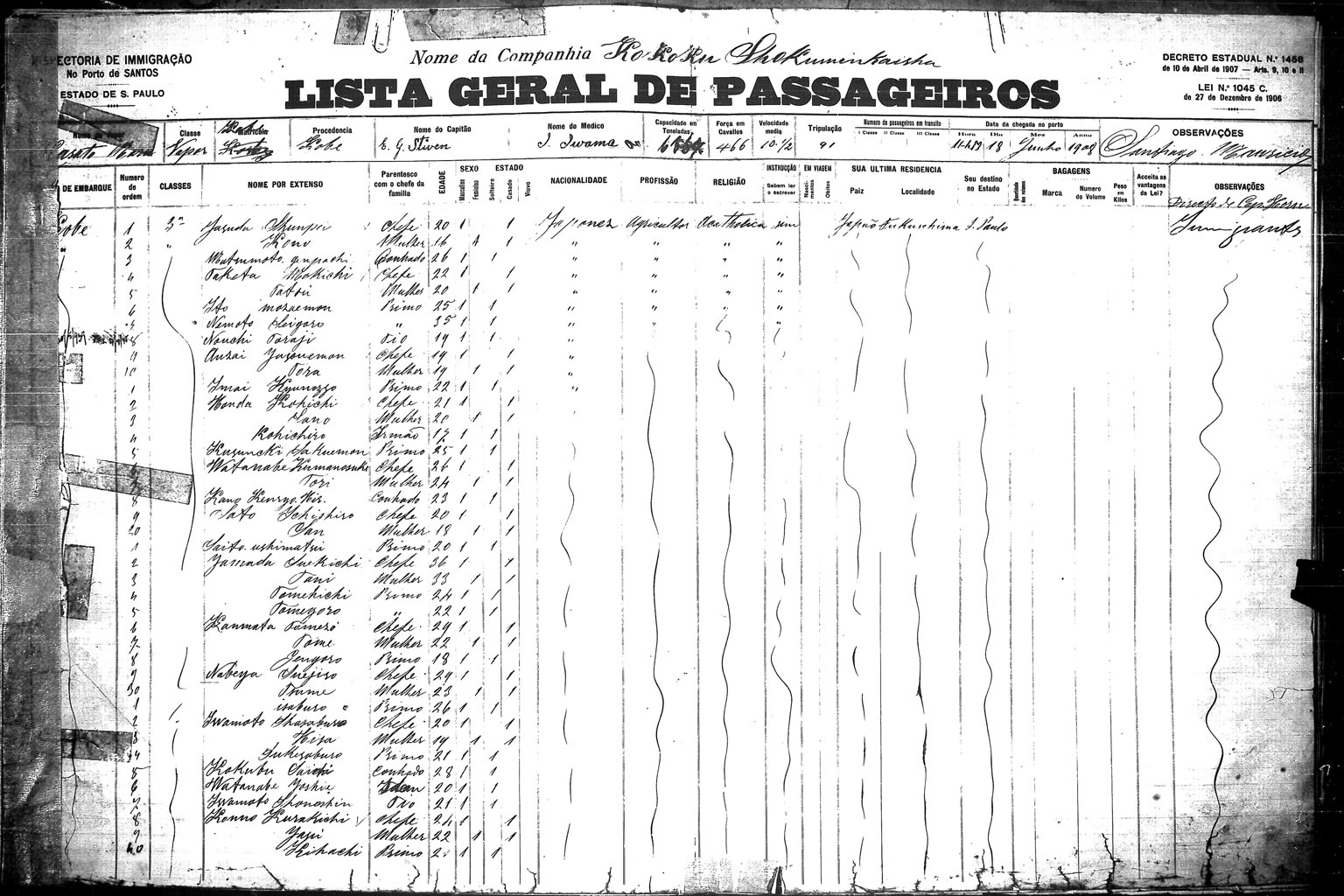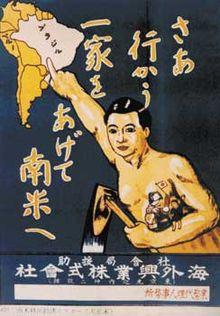In “Japanese, Brazilians, Nikkei: A Short History of Identity Building and Homemaking” Jeffrey Lesser explores the Japanese diaspora in Brazil. He starts his chapter by explaining how the Japanese-Brazilian population (also known as Nikkei) originated. He mentions that in 1908, fifteen years after the Japanese diplomat Sho Nemoto went to Brazil in an attempt to negotiate Japanese migration to Brazil, the first wave of Japanese immigration to Brazil started. The first ship called Kasato Maru, left Kobe in April 1908 and arrived in Santos, 60 km south of Sao Paulo, on June 18 of the same year. Although Lesser doesn’t specifically mention in the text, I find it valuable to notice that vast majority of these immigrants, 781 Japanese, came to Brazil with signed contracts through an agency to work at coffee plantations in Sao Paulo. Only about 12 of them did not have contracts (Nakamura). This is important because these contracts were one of the main reasons for the successful settlement of the Japanese community in Brazil. Before the Japanese diaspora, the Brazilian government promoted European immigration to the new country by offering to cover travel expenses. For many years, Italian immigrants would come to Brazil but face terrible work conditions to such an extent that the Italian government had to enact the “Decreed Prinetti”, prohibiting Italian subsidized immigration to Brazil (Santos). Thus, having the Japanese government behind the Japanese immigration gave these immigrants more chances of success in Brazil.

As Lesser mentioned, the Japanese faced a lot of issues once they arrived. Although they were provided with housing, clothing and food, their lower wages and poor living conditions led them to run away from plantations and look for other sources of profits. Some started their own coffee plantations which became bases for the Japanese to build their own communities in Brazil (Nakamura). In the 1920s, Japan became a key market for Brazil’s economy and the Nikkei ethnicity began to emerge. Although Japanese visibility at the time was increasing rapidly, political issues made the Japanese and the Nikkei community part of a paradox in Brazil. At the same time that they were in a position of superiority among the minorities, they began to be targeted by an anti-immigration campaign and face racism. Japanese schools and newspapers were banned and, by 1934, the new constitution caused the Japanese influx to Brazil to slow down substantially until the 1950s.

One point that I found very interesting in Lesser’s chapter is the rhetoric used by the Japanese government to promote immigration to Brazil. The Japanese government aimed to reduce its fast-growing population after the period of industrialization in the late 19th and early 20th centuries and reduce poverty among the rural population. As a result, the government saw emigration as the perfect solution and started promoting the idea of sending citizens abroad to make money and return to Japan with cash for their families. Meanwhile, the government also needed to convince the Brazilian elite that Japanese immigration was the solution for their problems on the plantations. At the time, Brazilian landowners were looking for submissive labor but were unsatisfied with European laborers, even though they wanted Europeans in Brazil in order to whiten its population. The Japanese, therefore, seemed to be the perfect match. The Japanese government sold them as the “white people of Asia” and, at the same time, as docile workers. As Lesser mentions the diplomat Sho Nemoto sold Japanese immigrants as “everything Europeans were not: quiet, hard-working and eager to become Brazilian” (5). As a result, from 1908 to 1941, 189,000 Japanese settled in Brazil giving origin to a new ethnic group that greatly contributed to the formation of a Brazilian identity. After WWII, about 50,000 more Japanese immigrants arrived in Brazil. As of 2009, according to the IBGE, there were about 1.6 million people of Japanese descent living in Brazil, which is 62% of the total 2.6 million people of Japanese descent living abroad (according to the Association of Nikkei and Japanese Abroad.)
The opposite also happened. As Daniel Linger sheds light in his chapter “Do Japanese Brazilians Exist?” with the examples of Moacir and Caesar, many Brazilians and Nikkeis have immigrated to Japan since the 1990s. Research shows that about 313,000 Brazilians, most of whom are of Japanese descent, were registered as Japanese residents as of December 2006. Although the Japanese government decided that Nikkeis are relatives of Japanese and therefore had the right to return to their primordial territory with the 1990 Immigration Control and Refugee Recognition Law, historical facts suggest that this argument relies on political and strategic motivations rather than reason. The political intention behind the 1990 act was to resolve labor shortage, especially in the construction and manufacturing industries during the 1980s and the 90s bubble economy. This raises the question about the divisive ideologies created by society with regard to race, gender, and other factors. What are the motivations behind these ideologies and what should be the real aspects of defining one’s identity? Personally speaking, Moacir and Caesar’s life stories suggest that identity should be voluntary rather than imposed. Unfortunately, race and ethnic discourse involve much deeper social issues than identity formation. As Linger mentions, divisive ideologies are directly tied to presumptions of superiority and can be strategically used by the dominant culture to maintain the current societal hierarchy.
Pictures: https://www.museubunkyo.org.br/fotos/index.html
Points to discuss with class:
1- Nippak Shinbun: https://www.portalnikkei.com.br/
2- Brasilidade: concept of one unified Brazilian identity
3- Diasporas as special cases of ethnic groups and kin relations:
Pg. 209 “ To characterize a group (Japanese Brazilians”) explicitly or implicitly as a diaspora is to draw a boundary around a set of persons on the basis of certain assumptions and to forward certain allegations about those so enclosed.”
4- The 1990 Japanese immigration law ties identity with blood. (Nikkei relatives of Japanese because of blood relationship of Japanese ancestry = right to return)
The political intention behind: designed to resolve labor shortage especially in the construction and manufacturing industries during the 1980s and 90s bubble economy.
5- Diaspora as the constitution of new ethnic groups with a new history, values, and collective mental state.
6- Are Japanese Brazilians a diaspora? Do they exist?
7- Other posts
Work Cited
Nakamura, Akemi. “Japan, Brazil Mark a Century of Settlement, Family Ties.” The Japan Times Online 15 Jan. 2008. Web. 23 Mar. 2017.
Santos, Mirian De Oliveira. “HISTORICA – Revista Eletronica do Arquivo do Estado.” HISTORICA – Revista Eletrnica do Arquivo do Estado. N.p., 2006. Web. 23 Mar. 2017.
